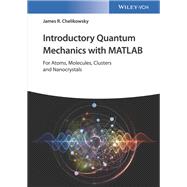
Note: Supplemental materials are not guaranteed with Rental or Used book purchases.
Purchase Benefits
Looking to rent a book? Rent Introductory Quantum Mechanics with MATLAB For Atoms, Molecules, Clusters, and Nanocrystals [ISBN: 9783527409266] for the semester, quarter, and short term or search our site for other textbooks by Chelikowsky, James R.. Renting a textbook can save you up to 90% from the cost of buying.
James Chelikowsky, PhD, holds the W.A. "Tex" Moncrief Chair at the University of Texas at Austin. He is a professor in the departments of physics, chemistry and chemical engineering. He also serves as the Director for the Center of Computational Materials in the Institute for Computational Engineering and Sciences.
Preface xi
1 Introduction 1
1.1 Different Is Usually Controversial 1
1.2 The Plan: Addressing Dirac’s Challenge 2
Reference 4
2 The Hydrogen Atom 5
2.1 The Bohr Model 5
2.2 The Schrödinger Equation 8
2.3 The Electronic Structure of Atoms and the Periodic Table 15
References 18
3 Many-electron Atoms 19
3.1 The Variational Principle 19
3.1.1 Estimating the Energy of a Helium Atom 21
3.2 The Hartree Approximation 22
3.3 The Hartree–Fock Approximation 25
References 27
4 The Free Electron Gas 29
4.1 Free Electrons 29
4.2 Hartree–Fock Exchange in a Free Electron Gas 35
References 36
5 Density Functional Theory 37
5.1 Thomas–Fermi Theory 37
5.2 The Kohn–Sham Equation 40
References 43
6 Pseudopotential Theory 45
6.1 The Pseudopotential Approximation 45
6.1.1 Phillips–Kleinman CancellationTheorem 47
6.2 PseudopotentialsWithin Density FunctionalTheory 50
References 57
7 Methods for Atoms 59
7.1 The Variational Approach 59
7.1.1 Estimating the Energy of the Helium Atom. 59
7.2 Direct Integration 63
7.2.1 Many-electron Atoms Using Density FunctionalTheory 67
References 69
8 Methods for Molecules, Clusters, and Nanocrystals 71
8.1 The H2 Molecule: Heitler–LondonTheory 71
8.2 General Basis 76
8.2.1 PlaneWave Basis 79
8.2.2 PlaneWaves Applied to Localized Systems 87
8.3 Solving the Eigenvalue Problem 89
8.3.1 An Example Using the Power Method 92
References 95
9 Engineering Quantum Mechanics 97
9.1 Computational Considerations 97
9.2 Finite Difference Methods 99
9.2.1 Special DiagonalizationMethods: Subspace Filtering 101
References 104
10 Atoms 107
10.1 Energy levels 107
10.2 Ionization Energies 108
10.3 Hund’s Rules 110
10.4 Excited State Energies and Optical Absorption 113
10.5 Polarizability 122
References 124
11 Molecules 125
11.1 Interacting Atoms 125
11.2 Molecular Orbitals: Simplified 125
11.3 Molecular Orbitals: Not Simplified 130
11.4 Total Energy of a Molecule from the Kohn–Sham Equations 132
11.5 Optical Excitations 137
11.5.1 Time-dependent Density FunctionalTheory 138
11.6 Polarizability 140
11.7 The Vibrational Stark Effect in Molecules 140
References 150
12 Atomic Clusters 153
12.1 Defining a Cluster 153
12.2 The Structure of a Cluster 154
12.2.1 Using Simulated Annealing for Structural Properties 155
12.2.2 Genetic Algorithms 159
12.2.3 Other Methods for Determining Structural Properties 162
12.3 Electronic Properties of a Cluster 164
12.3.1 The Electronic Polarizability of Clusters 164
12.3.2 The Optical Properties of Clusters 166
12.4 The Role of Temperature on Excited-state Properties 167
12.4.1 Magnetic Clusters of Iron 169
References 174
13 Nanocrystals 177
13.1 Semiconductor Nanocrystals: Silicon 179
13.1.1 Intrinsic Properties 179
13.1.1.1 Electronic Properties 179
13.1.1.2 Effective MassTheory 184
13.1.1.3 Vibrational Properties 187
13.1.1.4 Example of VibrationalModes for Si Nanocrystals 188
13.1.2 Extrinsic Properties of Silicon Nanocrystals 190
13.1.2.1 Example of Phosphorus-Doped Silicon Nanocrystals 191
References 197
A Units 199
B A Working Electronic Structure Code 203
References 206
Index 207
The New copy of this book will include any supplemental materials advertised. Please check the title of the book to determine if it should include any access cards, study guides, lab manuals, CDs, etc.
The Used, Rental and eBook copies of this book are not guaranteed to include any supplemental materials. Typically, only the book itself is included. This is true even if the title states it includes any access cards, study guides, lab manuals, CDs, etc.